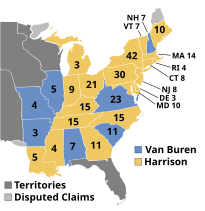
Back انتخابات الرئاسة الأمريكية 1840 Arabic ھەڵبژاردنی سەرۆکایەتیی ویلایەتە یەکگرتووەکانی ئەمریکا (١٨٤٠) CKB Præsidentvalget i USA 1840 Danish Präsidentschaftswahl in den Vereinigten Staaten 1840 German Elecciones presidenciales de Estados Unidos de 1840 Spanish انتخابات ریاستجمهوری ایالات متحده آمریکا (۱۸۴۰) Persian Yhdysvaltain presidentinvaalit 1840 Finnish Élection présidentielle américaine de 1840 French הבחירות לנשיאות ארצות הברית 1840 HE Elezioni presidenziali negli Stati Uniti d'America del 1840 Italian
| ||||||||||||||||||||||||||||||||
294 members of the Electoral College 148 electoral votes needed to win | ||||||||||||||||||||||||||||||||
|---|---|---|---|---|---|---|---|---|---|---|---|---|---|---|---|---|---|---|---|---|---|---|---|---|---|---|---|---|---|---|---|---|
| Turnout | 80.3% [1] | |||||||||||||||||||||||||||||||
| ||||||||||||||||||||||||||||||||
 Presidential election results map. Yellow denotes states won by Harrison/Tyler and Blue by Van Buren. Numbers indicate the number of electoral votes cast by each state. | ||||||||||||||||||||||||||||||||
| ||||||||||||||||||||||||||||||||
Presidential elections were held in the United States from October 30 to December 2, 1840. In the shadow of an incomplete economic recovery from the Panic of 1837, Whig nominee William Henry Harrison defeated incumbent President Martin Van Buren of the Democratic Party. The election marked the first of two Whig victories in presidential elections, but was the only one where they won a majority of the popular vote. This was also the third rematch in American history.
In 1839, the Whigs held a national convention for the first time. The 1839 Whig National Convention saw 1836 nominee William Henry Harrison defeat former Secretary of State Henry Clay and General Winfield Scott. Van Buren faced little opposition at the 1840 Democratic National Convention, but controversial Vice President Richard Mentor Johnson was not renominated. The Democrats thus became the only major party since 1800 to fail to select a vice presidential nominee.
Referencing vice presidential nominee John Tyler and Harrison's participation in the Battle of Tippecanoe, the Whigs campaigned on the slogan of "Tippecanoe and Tyler Too." With Van Buren weakened by economic woes, Harrison won a popular majority and 234 of 294 electoral votes. Voter participation surged as white male suffrage became nearly universal,[2] and a contemporary record of 42.4% of the voting age population voted for Harrison.[3] Van Buren's loss made him the third president to lose re-election.
The Whigs did not enjoy the benefits of victory. The 67-year-old Harrison, the oldest U.S. president elected until Ronald Reagan won the 1980 election, died a little more than a month after inauguration. Harrison was succeeded by John Tyler, who unexpectedly proved not to be a Whig. While Tyler had been a staunch supporter of Clay at the convention, he was a former Democrat, a passionate supporter of states' rights, and effectively an independent. As President, Tyler blocked the Whigs' legislative agenda and was expelled from the Whig Party, subsequently the second independent (after Washington) to serve as president. Van Buren would be the last incumbent president to lose his reelection bid in a general election until Grover Cleveland in 1888. And the last time a challenger to an incumbent President got a majority of the vote until 1932.
- ^ "National General Election VEP Turnout Rates, 1789-Present". United States Election Project. CQ Press.
- ^ "White Manhood Suffrage". National Museum of American History. Archived from the original on June 29, 2021. Retrieved July 6, 2021.
- ^ Between 1828–1928: "Voter Turnout in Presidential Elections: 1828–2008". The American Presidency Project. UC Santa Barbara. Retrieved November 9, 2012.
Cite error: There are <ref group=lower-alpha> tags or {{efn}} templates on this page, but the references will not show without a {{reflist|group=lower-alpha}} template or {{notelist}} template (see the help page).

